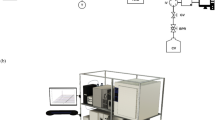Abstract
The rapid stripping chronopotentiometry (SCP) method was used to determine copper, lead, cadmium, and zinc in different kinds of vinegars (date, white grape, red grape, and apple) produced in Iran. The results of SCP were compared with graphite furnace atomic absorption spectrometry (GFAAS) as a reference method. There were no significant differences (p > 0.5) between the two methods. The range of concentration (ng/ml) of the analytes for heavy metals in different kinds of vinegars was as follows: copper (12.79–1,129), lead (3.32–253), cadmium (non-detectable concentration to 78), and zinc (26.12–3,725). The results demonstrated that it is possible to accurately determine the copper, lead, cadmium, and zinc content by direct analysis of vinegar samples using SCP method. The metal concentrations in all samples were lower than the maximum allowable limits legislated by the Institute of Standards and Industrial Research of Iran.



Similar content being viewed by others
References
Acosta A, Diaz C, Hardisson A, González D (1993) Levels of Cd, Pb, and Ni in different of types of vinegars. Bull Environ Contam Toxicol 51:852–856
Akpinar-Bayizit A, Turan MA, Yilmaz-Ersan L, Taban N (2010) Inductively coupled plasma optical-emission spectroscopy determination of major and minor elements in vinegar. Not Bot Hort Agrobot Cluj 38:64–68
Artiles AA, Romero CD, Torre HDL (1993) Concentration levels of metals in different types of vinegars. Die Nahrung 37:72–73
Codex Alimentarius (2000) Proposed draft revised regional standard for vinegar. Codex Alimentarius Commission, Joint FAO/WHO Food Standards Programme, June
Ebihara K, Nakajima A (1988) Effect of acetic acid and vinegar on blood glucose and insulin responses to orally administered sucrose and starch. Agric Biol Chem 52:1311–1312
Fallah AA, Saei-Dehkordi SS, Nematollahi A (2011a) Comparative assessment of proximate composition, physicochemical parameters, fatty acid profile and mineral content in farmed and wild rainbow trout (Oncorhynchus mykiss). Int J Food Sci Technol 46:767–773
Fallah AA, Saei-Dehkordi SS, Nematollahi A, Jafari T (2011b) Comparative study of heavy metal and trace element accumulation in edible tissues of farmed and wild rainbow trout (Oncorhynchus mykiss) using ICP-OES technique. Microchem J 98:275–279
Gonzalez AMT, Chozas MG (1988) Metallic contaminants in Andalusian vinegars. Die Nahrung 32:743–748
ISIRI (Institute of Standards and Industrial Research of Iran) (2007) Vinegar—Specifications, Iranian National Standards No. 355 (5th revision), Institute of Standards and Industrial Research of Iran
Kishi M, Fukaya M, Tsukamoto Y, Nagasawa T, Takehana K, Nishizawa N (1999) Enhancing effect of dietary vinegar on the intestinal absorption of calcium in ovariectomized rats. Biosci Biotechnol Biochem 163:905–910
Kondo S, Tayama K, Tsukamoto Y, Ikeda K, Yamori Y (2001) Antihypertensive effects of acetic acid and vinegar on spontaneously hypertensive rats. Biosci Biotechnol Biochem 65:2690–2694
Liljeberg H, Bjorck I (1998) Delayed gastric emptying rate may explain improved glycaemia in healthy subjects to a starchy meal with added vinegar. Eur J Clin Nutr 52:368–371
Liu Q (2010) Direct determination of mercury in white vinegar by matrix assisted photochemical vapor generation atomic fluorescence spectrometry detection. Spectrochim Acta B 65:587–590
Lo Coco F, Monotti P, Cozzi F, Adami G (2006) Determination of cadmium and lead in fruit juices by stripping chronopotentiometry and comparison of two sample pretreatment procedures. Food Control 17:966–970
Mazza S, Murooka Y (2009) Vinegars through the ages. In: Solieri L, Giudici P (eds) Vinegars of the World. Springer Italia, Milan, pp 17–39
Ndung’u K, Hibdon S, Flegal AR (2004) Determination of lead in vinegar by ICP-MS and GFAAS: evaluation of different sample preparation procedures. Talanta 64:258–263
Saei-Dehkordi SS, Fallah AA (2011) Determination of copper, lead, cadmium and zinc content in commercially valuable fish species from the Persian Gulf using derivative potentiometric stripping analysis. Microchem J 98:156–162
Saei-Dehkordi SS, Fallah AA, Nematollahi A (2010) Arsenic and mercury in commercially valuable fish species from the Persian Gulf: influence of season and habitat. Food Chem Toxicol 48:2945–2950
Turkish Food Codex (2002) Communiqué on the Maximum Levels of Certain Contaminants in Foodstuffs. Communiqué No: 2002/63
Volpe MG, La Cara F, Volpe F, De Mattia A, Petitto VF (2009) Heavy metal uptake in the enological food chain. Food Chem 117:553–560
Acknowledgments
The authors are grateful to the Shahrekord University for supporting this research.
Author information
Authors and Affiliations
Corresponding author
Rights and permissions
About this article
Cite this article
Saei-Dehkordi, S.S., Fallah, A.A. & Ghafari, E. Determination of Lead, Cadmium, Copper, and Zinc Content in Commercial Iranian Vinegars Using Stripping Chronopotentiometry. Food Anal. Methods 5, 767–773 (2012). https://doi.org/10.1007/s12161-011-9303-4
Received:
Accepted:
Published:
Issue Date:
DOI: https://doi.org/10.1007/s12161-011-9303-4




